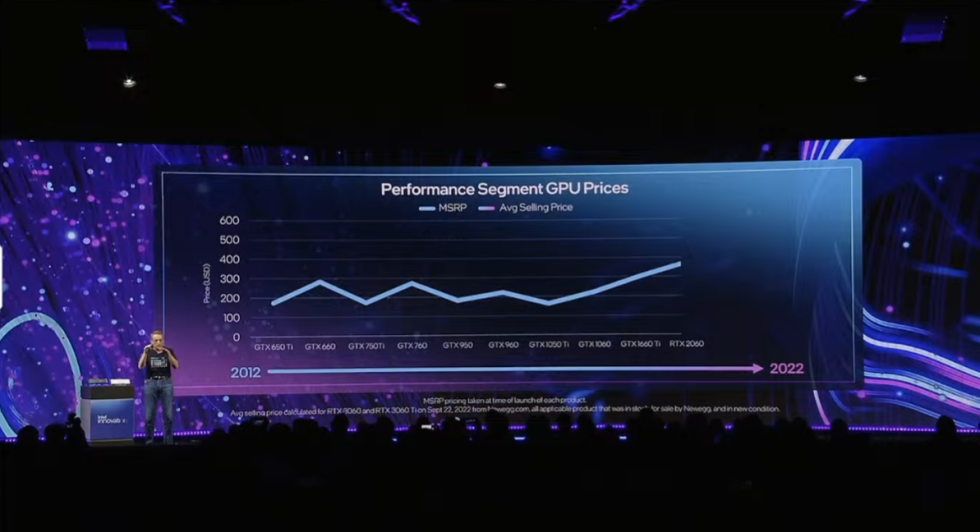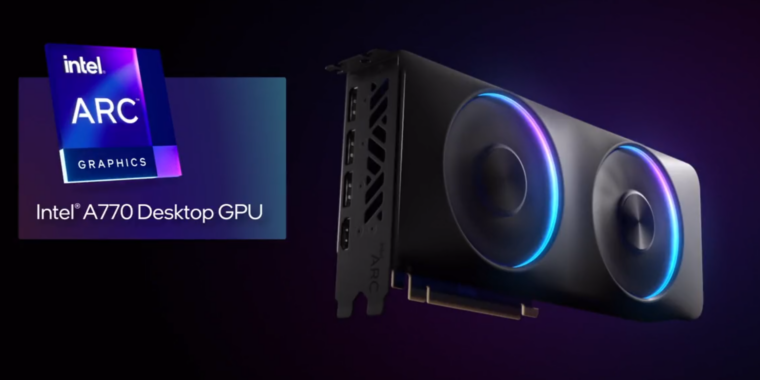Intel
One week after Nvidia moved forward with some of its highest graphics card prices, Intel emerged with splashy news: a price for its 2023 graphics cards that lands a bit closer to Earth.
Intel CEO Pat Gelsinger took the keynote stage on Tuesday at the latest Intel Innovation event to confirm a starting price and release date for the upcoming Arc A770 GPU: $329 on October 12.
That price comes well below last week’s highest-end Nvidia GPU prices but is meant to more closely correlate with existing GPUs from AMD and Nvidia in the $300 range. Crucially, Intel claims that its A770, the highest-end product from the company’s first wave of graphics cards, will compare to or even exceed the Nvidia RTX 3060 Ti, which debuted last year at $399 and continues to stick to that price point at most marketplaces.
While we have yet to personally test Intel’s pair of 700-series GPUs, the tale of their tape points to comparable hardware, with 4,096 shading units (compared to the 3060 Ti’s 4,864 CUDA cores), 16GB of GDDR6 RAM (compared to 3060 Ti’s 8GB GDDR6), and a boost clock of 2.1 GHz (compared to 3060 Ti’s 1.67 GHz). So far, initial comments made by Intel to Ars Technica point to higher performance on modern games running in DirectX 12—and even improved ray tracing performance thanks to several focused hardware features to make that performance efficient in existing DX12 RT games. However, Intel also suggested to Ars that, in the short term, 3D software running in older APIs will likely suffer from a mix of early Intel GPU drivers and minimal performance optimization.
Intel has not yet announced a price or release window for its other 700-series GPU, the Arc A750. So far, the company has suggested that this GPU, which has lower specs across the board but is otherwise in arm’s reach of the A770, will compare directly to Nvidia’s RTX 3060 (not Ti).

Intel
Before announcing the 770’s price and release date, Gelsinger pointed to a chart of “performance segment GPU prices” that charted Nvidia’s mid-range GPU launches since the GTX 650 Ti. “We are, with gamers, delivering and hearing the complaints of high prices,” Gelsinger said as he pointed to the current costs of RTX 3060 and 3060 Ti models in the wild. “You should be frustrated, because you are missing out as the gaming community. And today, we’re fixing that.”
Gelsinger’s presentation included multiple declarations that “Moore’s law is not dead,” apparently referencing a comment made by Nvidia CEO Jensen Huang last week in light of his company’s announcements of the RTX 4090 and RTX 4080. Gelsinger even stood in front of a slide about its full production pipeline of various chips, stating, “Moore’s Law: Alive and Well.” He added, “We will continue to be the stewards of Moore’s law.”

